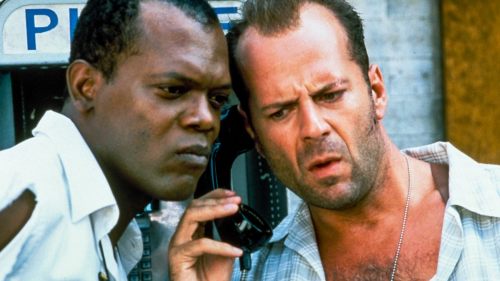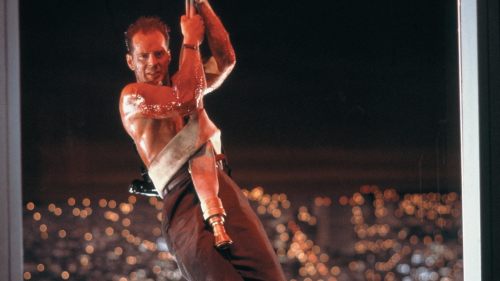DIE HARD (And Me) At 30
Milestone birthdays are always a little bit of a shock when they happen, but somehow it’s even more surreal when you share that birthday with someone or something of cultural significance. I was born on July 11, 1988, in a Portland, Oregon hospital. 24 hours later, and just under 1,000 miles south of where I lay in a maternity ward bassinet, Die Hard yippie-ki-yayed its way into the world at a theater in L.A. Last week, Die Hard and I turned 30.
Thirty is a big number, but it seems even bigger placed against a movie so iconic it feels like there was never a time when it didn’t exist. I’m part of a generation whose understanding of movies was shaped in large part by Die Hard, its sequels, and the myriad knockoffs it inspired. For the first decade of my life, I believed action movies were the ultimate “grown-up” entertainment, because their billboards and trailers were everywhere I looked. They were an experience I couldn’t have “until I was older,” a locked gate guarded closely by Nicolas Cage, Keanu Reeves, Samuel L. Jackson and Bruce Willis--in my early estimation, the biggest badass of the bunch.
But sharing a birthday with Die Hard actually serves a bigger purpose than being a generational marker. Watching it to write about its 30th anniversary, as I turned 30 myself, I was surprised to discover the movie actually contains some valuable lessons for getting older. I don’t mean how to survive a hostage situation (though who knows these days). I mean the core reason John McTiernan’s 1988 blockbuster is still one of the best action films of all time: self-knowledge. Die Hard understands exactly what kind of movie it is, aspires to be the best version of that movie, and gets implicitly the actions, choices and characters that inform its every moment.
From moment one, Die Hard knows its cinematic identity and its purpose. It is a gritty, effects-laden extravaganza, here to give us explosions, snarky humor and swagger as macho and American as a rare hamburger at a Fourth of July cookout. This movie is not here to educate you, make you ask hard questions or reexamine your life. It is here to entertain, plain and simple. But McTiernan and screenwriters Jeb Stuart and Steven E. de Souza make sure Die Hard not only recognizes the audience’s expectations, but meets them in the most satisfying way possible through impeccably efficient storytelling and plot construction.
Take how the movie addresses exposition. Where plenty of films rely on info-dump dialogue to plow through the setup and get to the action, Die Hard creates that setup without feeling obvious. In the opening, as McClane talks to his airplane seatmate, and later to Argyle the chauffeur, we learn everything we need to know about him. He’s a cop from New York, visiting his estranged family in L.A. for Christmas, and he hopes it’ll be a chance for reconciliation. When we’re introduced to McClane’s wife Holly (Bonnie Bedelia), we are shown, not told, all the necessary details. The family photo on her desk tells us who she is in relation to McClane. Her phone call to their kids establishes that in six short months she’s created a good life for herself. Her quick rebuff of her sleazy co-worker’s advances shows that she’s a woman of principle.
The script’s subtle series of setups and payoffs prove that this movie also knows how each scene informs the ones that come after. Nothing happens for inexplicable reasons. Even seemingly throwaway lines serve a purpose. The tip in the opening scene that McClane “make fists with his toes” to settle in after traveling is what causes his barefoot state for most of the film. Mr. Takagi’s casual mention that several floors of Nakatomi Plaza are still under construction becomes vital information when McClane is hiding from Alan Rickman’s Hans Gruber. After the failed first raid on the building by the L.A.P.D., Paul Gleason’s Deputy Chief Robinson complains about all the broken glass. McClain makes fun of him, but is forced to eat his words a few scenes later, when he shreds his feet walking over a floor that’s also covered in broken glass.
These same base filmmaking principles also provide a pretty good model for gracefully transitioning to this next stage of my life. I’m far from having everything figured out, but I try as much as I can to live into my purpose. I’m not perfect, but at least I know my strengths, and I play to them. I’m also aware of how this part of my life is informed by a whole string of events, people and choices that came before it, both big, significant ones, and ones that seemed unimportant at the time.
The movies that shape our cultural knowledge inform who we are, and sometimes that’s not always about content, but the form that content takes. For years I thought what made Die Hard the iconic action movie I loved was limited to its content. I thought it was just about Willis’ tough-but-vulnerable everyman, Rickman’s bespoke German baddie, massive explosions and Run-D.M.C.’s “Christmas in Hollis” on the soundtrack. These are still all fantastic, don’t get me wrong. But they aren’t what makes Die Hardlast. It took leaving my 20s behind to figure out that the movie’s strength runs deeper than that. Die Hard’s true power lies in its form, which ensures that it will still hold up not just at 30, but at 40, 50 and 60. Maybe that means there’s hope for the rest of us, too.


